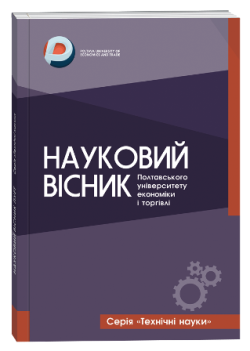THE VALUE OF REMANUFACTURING PROCESSES IN THE ELECTRONICS INDUSTRY
Abstract
In recent years, the field of circular economy, in particular, renewable production in the electronics industry, has attracted considerable attention due to its various benefits and key role in the implementation of fundamental principles of value preservation. This is due to the alarming rate of use of natural resources and, as a result, the risk of shortages of some resources, as well as environmental, social and economic changes in the economy. Shifting from a linear economy, where products are discarded after use, to a circular economy, where products and materials remain in the system as long as possible, will contribute to a more sustainable future. These are innovations in production and consumption. Innovations where we move away from resource-intensive models of production and consumption to efficient processes, where innovation will drive change, which is essential to achieving the goals of sustainable development. The rapid development of technologies in the modern electronics industry and the growing demand for new devices are accompanied by significant volumes of electronic waste, which negatively affects the environment and the consumption of natural resources. In response to these challenges, value retention strategies (VRPs), which are key elements of the circular economy, are gaining increasing attention. This paper discusses ways to implement VRP in electronics manufacturing, which involves optimizing processes at all stages of the product life cycle, from raw material extraction to its disposal. The introduction of VRP in the electronics industry has the potential to significantly reduce waste and reduce the negative impact on the environment. This is achieved by extending the life cycle of products, reusing components and materials, and implementing more efficient recycling methods. However, the effectiveness of VRP implementation largely depends on the specifics of the industry and the particular conditions of use. On the other hand, in other segments, such as consumer electronics, where product refresh cycles are less intensive, VRP can be implemented at lower costs and faster. Among the advantages of VRP are not only lower material costs and reduced dependence on primary resources, but also the possibility of creating new business models based on product maintenance and reuse. However, the disadvantages may include the difficulty of integrating these processes into existing production chains, as well as the need for significant changes in business structure and staff training.
References
2. United States International Trade Commission. Remanufactured Goods: An Overview of the U.S. and Global Industries, Markets and Trade. USITC Publication No. 4356, 2012, p. 245
3. European Remanufacturing Network. Remanufacturing in Europe: A Snapshot of the European Remanufacturing Industry. European Commission, 2015, p. 80.
4. Pomponi F., Moncaster A. Circular economy for the built environment: a research framework, J. Clean. Prod., 143, 2017, pp.710–718.
5. Environmental Audit Committee Electronic waste and the Circular Economy Volume 1, Report (House of Commons Paper), HC 220 Paperback, 2020, p.79.
6. Ellen MacArthur Foundation Towards the Circular Economy: Economic and Business Rationale for an Accelerated Transition., Cowes, UK: Ellen MacArthur Foundation, 2013, p. 96.
7. Mamudu U. U., Obasi C. D., Awuye S. K., Danso H., Ayodele P., Akinyemi P. Circular economy in the manufacturing sector: Digital transformation and sustainable practices, International Journal of Science and Research Archive, 12(02), 2024, pр. 129–141.
8. Potting J., Hekkert M., Worrell E., Hanemaaijer A. Circular Economy: Measuring Innovation in the Product Chain, Policy Report., 2017, p. 46.
9. Reike D., Vermeulen W., Witjes S. The circular economy: New or Refurbished as CE 3.0? – Exploring Controversies in the Conceptualization of the Circular Economy through a Focus on History and Resource Value Retention Options, Conservation and Recycling, 135, 2018, pp. 246–264.
10. Stijn A., Eberhardt L., Wouterszoon J., Meijer A. Design guidelines for circular building components based on LCA and MFA., IOP Conf. Ser. Earth Environ. Sci., 588, 2020, рр.1–8.
11. Behrens J. L., Wills A. T. Impact of Early Design Decisions on Production Costs and Environmental Outcomes, Environmental Impact Assessment Review, Vol. 42, No. 2, 2016, pp. 112–125.
12. Smith J., Brown L. Modular Systems in Manufacturing: Reducing Waste by 50%, Journal of Sustainable Manufacturing, 15(4), 2023, pp. 234–245.
13. Wang X., Lee M. The Impact of Modular Design on Waste Reduction in the Electronics Industry, Environmental Science & Technology, 57(7), 2023, pp. 892–900.
14. Bocken N., Pauw I., Bakker C., Grinten B. Product design and business model strategies for a circular economy, Journal of Industrial and Production Engineering, 33, 2016, рр. 308–320.
15. Schischke K., Proske M., Nissen N.F., Lang K.D. Modular products: Smartphone design from a circular economy perspective., Electronics Goes Green 2016 (EGG), 2016, рр. 1–8.
16. Cooper T. Longer Lasting Products: Alternatives to the Throwaway Society, Routledge, London, 2016, pp. 11–34.
17. Yla-Mella J., Roman E. Circular Economy Strategies for Electric and Electronic Equipment: A Review, Environmental Engineering and Management Journal, 16(8), 2019, pp. 1807–1817.
18. Ellen MacArthur Foundation Circular Economy in Electronics: Getting the Circulation Going, Ellen MacArthur Foundation, Cowes, UK, 2019, pp. 22–30.
19. Despeisse M., Baumers M., Brown P., Charnley F., Ford S., Garmulewicz A., Knowles S., Minshall T., Mortara L., Reed-Tsochas F., Rowley J. Unlocking value for a circular economy through 3D printing: A research agenda, Technological Forecasting and Social Change, 115, 2017, pp.75–84.
20. Bressanelli G., Adrodegari F., Perona M., Saccani N. Exploring How Usage-Focused Business Models Enable Circular Economy through Digital Technologies, Sustainability, 10(3), 2018, pp.639.


